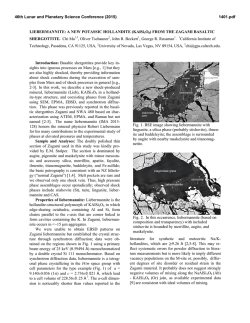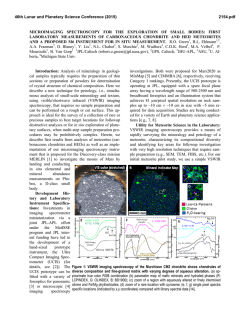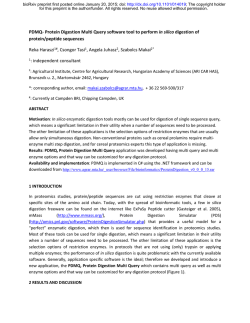
Study of start-up of a continuous digester on a laboratory
Revue des Energies Renouvelables Vol. 15 N°2 (2012) 229 – 234 Study of start-up of a continuous digester on a laboratory scale treating the sludge issued from wastewater treatment plant in Adrar city (south west of Algeria) S. Kalloum *, M. Khelafi, M. Djaafri, A. Tahri, K. Kaïdi and A. Touzi Unit of Research in Renewable Energies in Saharan Medium P.O. 478, Reggane Street, Adrar, Algérie (reçu le 15 Juillet 2011 – accepté le 30 Mars 2012) Abstract - A continuous digester type was designed at the laboratory scale with an aim to studying and improving anaerobic digestion of organic wastes. The results obtained can be extrapolated at large scale pilot plant. To study the digester start-up we have chosen as a substrate the sludge issued from the wastewater treatment plant located in Adrar city (south west of Algeria). Different parameters have been considered such as pH, VFA, COD, and volume of biogas generated during the digestion process. Résumé - Un type de digesteur en continu a été développé à l’échelle du laboratoire dans le but d’étudier et d’améliorer la digestion anaérobie des déchets organiques. Les résultats obtenus peuvent être extrapolés à l’échelle d’un pilote industriel. Pour étudier ce pilote de digesteur, nous avons choisi comme substrat de la boue provenant de l’usine de traitement des eaux usées, située à Adrar ville (sud-ouest de l’Algérie). Différents paramètres ont été considérés comme le pH, les AGV, les COD, et le volume de biogaz produit lors du processus de la digestion. Keywords: Sludge - Anaerobic digestion - Organic wastes – Digester. 1. INTRODUCTION Evacuation, treatment and general municipal wastes management in developing countries (DCs) are crucial. Demographic change and urbanization made the amount of waste released to grow, until becoming a major concern, faced by these countries representatives. Local authorities, thanks to international assistance, have engaged comprehensive waste management policies, to define a path of treatment best suited to local conditions. Waste treatment mode retained in developing countries is most often directed towards landfill, but now most of the waste is disposed of on the outskirts of cities in landfills or sewage treatment plants more or less controlled. Waste loses a potential recovery in terms of recycling materials and energy and organic fertilizers production. In this context, we launched anaerobic digestion program by focussing on the startup of a continuous digester, treating sludge issued by wastewater treatment plant in Adrar city. 2. MATERIALS AND METHODS 2.1 Materials The experiments were carried out using a continuous digester. The laboratory scale reactor was made using PVC tube with an internal diameter of 200 mm and an overall * [email protected] 229 230 S. Kalloum et al. height of 500 mm. The active volume was 12 liters (Fig. 1), the digester was maintained at mesophilic temperature range (35 ± 2 °C) (Bougrier et al.). The digester was equipped with inlet and outlet ports for feeding and effluent discharge. A plastic tube connected the vial to an inverted Marriotte flasck of 0.25 l that contained an alkaline solution (2.5 % NaOH), so CO2 was absorbed into the alkaline solution and the volume of CH4 generated was measured as the displaced liquid volume (Soto et al.). Fig. 1: Schematic system -1- Inlet, 2- Outlet, 3- Digestion tank, 4- Digester base, 5- Lid, 6- Collecting biogas pipe, 7- Water bath, 8- Substrate level, 9- Electric resistance with thermostat The substrate used for this experiment was sludge collected in Adrar city municipal wastewater treatment plant. The Organic Loading Rate (OLR) was 16 g/l of total solids (TS), was fermented in a continuous digester of twelve litters capacity under anaerobic conditions, in order to avoid the medium acidification during the start up period, cause the acids accumulation could hamper anaerobic digestion process (Elmitwalli et al.). After this, the Organic Loading Rate was increased until 30g/l TS. 50 ml of waste obtained from the slaughterhouses were used as incolum. The waste characteristics were presented in Table 1. Table 1: Inoculum characteristics Inoculum COD (mg/l) T.S. (%) V.S. (%) Slaugherhouses wastes 1000 28 90 2.2 Analytical techniques pH was measured using phmeter HANNA 8141. Volatile Fatty Acids (VFA) and Total Alkalinity (T.A.), concentrations have been achieved according to the method described by (Jardie). Chemical Demand in Oxygen (COD), Total Solids (T.S.), Volatile Solids (V.S.) their concentrations were carried out according to (APHA). Study of start-up of a continuous digester on a laboratory scale treating the sludge... 231 3. RESULTS AND DISCUSSION The pH variation recorded during anaerobic digestion process presented a slight decrease during the first ten days (from 7.4 to 7.1), when the organic loading rate was 16 g/l TS, (Fig. 2). In contrast, dropped drastically from 7.1 to 5.6 after the 17th days when the Organic Loading Rate was increased to 30 g/l TS, that enabled us to deduce that the amount of acid produced during the hydrolysis and acid genesis phases was proportional to the organic matter rate introduced into the digester. This was in conformity with the findings achieved by (Hutnan et al.) and (Deng et al.). From the 25th day until the end of the digestion process the pH increased and remained stable in the vicinity of 7. Fig. 2: pH variation during the time The Total Alkalinity in the digester increased from 550 mg/l at an OLR of 16g/l to 4780 mg/l at an OLR of 30 g/l (Fig. 3). Alkalinity is known to be a critical buffering factor for neutralizing VFA during methanogenesis (Shahrakbah et al.). Fig. 3: TA variation during the time 232 S. Kalloum et al. The VFA concentration in the effluent at the initial OLR of 16 g/l T.S. was in the range of 250 - 500 (mg acitic acid /L) during the first 17 days of the digestion (Fig. 4), after that, the curve showed an increase in VFA up to 2000 mg of acetic acid/l. This VFA production phase corresponded to the hydrolysis acidogenesis phase identified by (Hill et al.) and (Aguilar et al.). The decrease in VFA after the 28 day was due to the consumption of VFA by bacteria which could correspond to the acetogenesis phase. Fig. 4: VFA variation during the time In Fig 5 we illustrated the report of VFA/TA variation and showed that this report was for all the digestion process lower than 0.5. This value, was quoted by (Nguyen et al.) and (Rao et al.) which indicated the feasibility of the process in spite of the significant VFA production. The presence of these latter could inhibit the anaerobic digestion process. (Chanakya et al.). Fig. 5: VFA/TA variation during the time On Fig. 6 we presented the produced biogas volume variation during the digestion. We noted a weak production during the first 17 days, just after, the volume of gas increased considerably, reaching an average value of 2500 nml/d. The total volume of biogas produced during this period was 45 l. Study of start-up of a continuous digester on a laboratory scale treating the sludge... 233 Fig. 6: Biogas volume variation during time Fig 7 showed a small increase in the value of COD for the first five days, after that we observed a slight decrease of COD, due to the organic matter degradation. The sharp increase in the value of COD from 17th days was due to substrate addition. Then there was a rapid decline from 30th day of 6000 mg/l to a mean value of 4000 mg/l. This decrease is explained by the high bacterial activity. Fig. 7: COD variation during time 4. CONCLUSION Continuous digester start up study has been achieved. We found that the methanisation phase starting was based on the amount of total solid introduced. The pH variation of the medium and the volume of biogas produced were also proportional to the amount of organic matter introduced. The process of digestion has been boosted by the VFA presence and a TA which the report did not exceed 0.5. Anaerobic digestion also enabled significant cleanup of organic matter. In our conditions it was 2000 g / l (COD) removed for a period of 15 days only. 234 S. Kalloum et al. REFERENCES [1] A. Aguilar, C. Casas and J.M. Lema, ‘Degradation of Volatile Fatty Acids by Differently Enriched Methanogenic Cultures: Kinetics and Inhibition’, Water Research, Vol. 29, N°2, pp. 505 – 509, 1995. [2] Report, APHA., Standard Methods for the Examination of Water and Waste Water’, Washington, USA: American Public Health Association, 1998. [3] C. Bougrier, J.P. Delgenès and H. Carrère, ‘Effects of Thermal Treatments on Five Different Waste Activated Sludge Samples Solubilization, Physical Properties and Anaerobic Digestion’, Chemical Engineering Journal, Vol. 139, N°2, pp. 236 – 244, 2008. [4] H.N. Chanakya, B.V.V Reddy and J. Modak, ‘Biomethanation of Herbaceous Biomass Residues Using 3-Zone Plug Flow Like Digesters – A Case Study from India’, Renewable Energy, Vol. 34, N°2, pp. 416 – 420, 2009. [5] T.A. Elmitwalli, V. Sklyar, G. Zeeman and G. Lettinga, ‘Low Temperature PreTreatment of Domestic Sewage in an Anaerobic Hybrid and an Anaerobic Filter Reactor’, Bioresource Technology, Vol. 82, N°3, pp. 233 – 239, 2002. [6] D.T. Hill and J.P. Bolte, ‘Methane Production from Low Solid Concentration Liquid Swine Waste Using Conventional Anaerobic Fermentation’, Bioresource Technology, Vol. 74, N°3, pp. 241 – 247, 2000. [7] M. Hutnan, M. Drtil and A. Kalina, ‘Decoloration of Textile Wastewater by Means of a Fluidized-Bed Loop Reactor and Immobilized Anaerobic Bacteria’, Journal of Hazardous Materials, Vol. 135, N°1-3, pp. 163 - 169, 2006. [8] E. Jardie, ‘Composition Organique de Boues Résiduaires de Stations d’Epuration Lorraines: Caractérisation Moléculaire et Effets de la Biodégradation’, Thèse de Doctorat, Université Henri Poincaré, Nancy I. Nancy, 2002. [9] L.W. Deng, Z. Ping and Z.A. Chen, ‘Anaerobic Digestion and Post-Treatment of Swine Wastewater Using IC–SBR Process with Bypass of Raw Wastewater’, Process Biochemistry, Vol. 41, N°4, pp. 965 – 969, 2006. [10] P.H.L. Nguyen, P. Kuruparan and C. Visvanathan, ‘Anaerobic Digestion of Municipal Solid Waste as a Treatment Prior to Landfill’, Bioresource Technology, Vol. 98, N°2, pp. 380 – 387, 2007. [11] M.S. Rao and S.P. Singh, ‘Bioenergy Conversion Studies of Organic Fraction of MSW: Kinetic Studies and Gas Yield-Organic Loading Relationships for Process Optimization’, Bioresource Technology, Vol. 95, N°2, pp. 173 – 185, 2004. [12] Y. Shahrakbah, S. Yoshihito, H. Mohd Ali, W. Minato and S. Sunderaj, ‘Strat-up Operation of Semi-Commerciel Closed Anaerobic Digester for Plam Oil Mill Effluent Treatment’, Process Biochemistry, Vol. 41, N°4, pp. 962 – 964, 2006. [13] M. Soto, R. Mèndez and J.M. Lema, ‘Methanogenic and Non-Methanogenic Activity Tests. Theoretical Basis and Experimental Set Up’, Water Research, Vol., N°8, pp. 1361 – 1376, 1993.
© Copyright 2025


